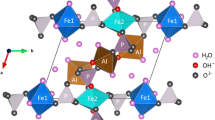Abstract
Natural and synthetic olivines with ferrous and ferric iron have been studied by Mössbauer spectroscopy. Their spectra exhibit three superimposed quadrupole-split doublets corresponding to Fe2+ at M1 and M2 sites and Fe3+ at an unidentified position, which is probably M2. The hyperfine parameters of Fe3+ at temperatures between 300°C and 450°C are: Δ=0.67–1.23 mm/s, δ=0.04–0.23 mm/s relative to metallic iron, and the full width at half height, HW=0.15–0.43 mm/s.
The Fe2+ populations of M2 decrease with increasing Fe3+ content. However, Fe2+ prefers M1 in synthetic olivines, even at high temperatures (800°–1,400°C). In kirschsteinite, Fe2+ and Fe3+ are exclusively in M1. Fe2+/Fe3+ ratios estimated from the peak areas are consistent with chemical analyses.
Similar content being viewed by others
References
Bancroft GM, Maddock AG, Burns RG (1967) Applications of the Mössbauer effect to silicate mineralogy-I. Iron silicates of known crystal structure. Geochim Cosmochim Acta 31:2219–2246
Bancroft GM, Brown JR (1975) A Mössbauer study of coexisting hornblendes and biotites: Quantitative Fe3+/Fe2+ ratios. Am Mineral 60:265–272
Brown GE, Prewitt CT (1973) High-temperature crystal chemistry of hortonolite. Am Mineral 58:577–587
Bush WR, Hafner SS, Virgo D (1970) Some ordering of iron and magnesium at the octahedrally coordinated site in a magnesium-rich olivine. Nature 227:1339–1341
Champness PE (1970) Nucleation and growth of iron oxides in olivine. Mineral Mag 37:790–800
Chatelain A, Weeks RA (1973) Electron paramagnetic resonance of Fe3+ in forsterite (Mg2SiO4). J Chem Phys 58:3722–3726
Deer WA, Howie RA, Zussman J (1962) Rock forming minerals. Longmans, New York, pp 10–13
Duba A, Ito J, Jamieson JC (1973) The effect of ferric iron on the electrical conductivity of olivine. Earth Planet Sci Lett 18:279–284
Eibschütz M, Ganiel V (1967) Mössbauer studies of Fe2+ in paramagnetic fayalite (Fe2SiO4). Solid State Commun 5:267–270
Finger LW, Virgo D (1971) Confirmation of Fe/Mg ordering in olivines. Carnegie Inst. Washington Yearb 70:221–225
Fleischer M, Cabri LJ, Chao GY, Pabst A (1978) New mineral names. Am Mineral 63:424–427
Kündig W, Cape JA, Lindquist RH, Constabaris G (1967) Some magnetic properties of Fe2SiO4 from 4°K to 300°K. J Appl Phys 38:947–948
Niebuhr HH (1975) Electron spin resonance of ferric iron in forsterite, Mg2SiO4. Acta Crystallogr Sect A: 31:S 3, S 274
Nitsan U (1974) Stability field of olivine with respect to oxidation and reduction. J Geophys Res 79:706–711
Shinno I (1974) Mössbauer studies of olivines. The relation between Fe2+ site occupancy number TMi and interplanar distance d130. Mem Geol Soc Jpn 11:11–17
Shinno I, Hayashi M, Kuroda Y (1974) Mössbauer studies of natural olivines. Mineral J 7:344–358
Virgo D, Hafner SS (1972) Temperature dependent Mg, Fe distribution in a lunar olivine. Earth Planet Sci Lett 14:305–312
Author information
Authors and Affiliations
Rights and permissions
About this article
Cite this article
Shinno, I. A Mössbauer study of ferric iron in olivine. Phys Chem Minerals 7, 91–95 (1981). https://doi.org/10.1007/BF00309458
Received:
Issue Date:
DOI: https://doi.org/10.1007/BF00309458



